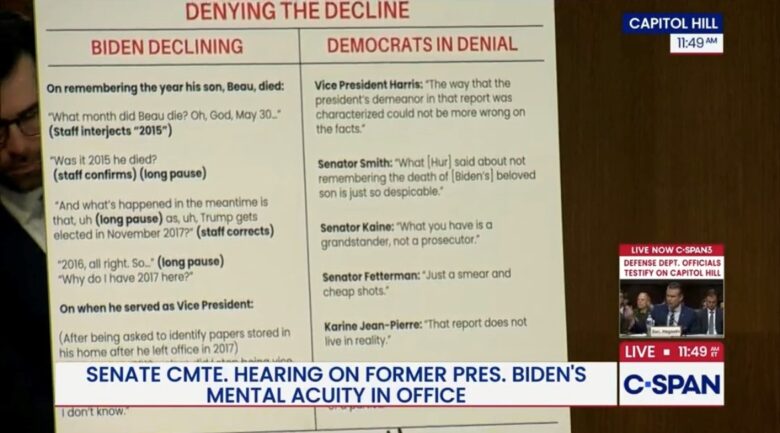Overview:
Senators and legal scholars clashed during a tense hearing this week focused on former President Biden’s cognitive health and the increasingly frequent use of the presidential autopen. Testimony revealed the White House began using the autopen under Biden’s name just days into his presidency. With key executive orders and pardons digitally signed, experts and lawmakers are calling for clear records showing who was logged in and when. Senator Josh Hawley and others questioned whether constitutional boundaries have been tested—especially when decisions of great consequence were digitally rubber-stamped from undisclosed locations.
WASHINGTON, D.C. — This week’s hearing titled “Presidential Capacity and Constitutional Process” held before the Senate Committee on Oversight and Accountability cracked open a rarely discussed but increasingly relevant issue. The issue is the Biden administration’s use of the autopen. The technology enables documents to be “signed” without the physical presence of the President. It came under the microscope as officials and scholars debated its legal standing and ethical implications. This is especially relevant given former President Biden’s health concerns during his term.
According to multiple sources presented during the hearing, the Biden White House began using the autopen as early as Day 5 of the administration. Assistant Attorney General Theodore Wold, who serves in DOJ leadership, testified about the first wave of digital signatures under Biden’s name. These signatures were applied to executive orders tied to pharmaceutical policies, including actions involving Pfizer, and early pandemic recovery legislation.
Wold also raised concerns about pardons processed via autopen. He recommended that a detailed record of each log-in session associated with autopen usage be made public. Furthermore, he warned that such a process, if unregulated, could serve as a loophole in presidential accountability.
“The American people deserve to know who was logged into the system and whether President Biden was actively engaged in these decisions,” Wold said.
Hearing Highlights:
The hearing brought together voices from across the legal spectrum, including Professor John Harrison of the University of Virginia. He emphasized the lack of constitutional clarity on the matter.
“The Constitution simply doesn’t address autopen use directly,” said Harrison. “However, in an age where the President may need to act globally and instantaneously, it’s understandable that digital signatures might be used—but only when paired with transparency and oversight.”
That’s where the conversation pivoted to the idea of “paper flow”. This term was used in the hearing to describe the digital paper trail or audit log attached to each autopen action. According to testimony, the record of who authorized, accessed, and executed the signature remains vague at best. This is despite repeated Freedom of Information Act (FOIA) requests by watchdog organizations.
“This isn’t just about a pen—it’s about trust,” said Senator Josh Hawley (R-MO) during the session. “If we can’t determine who clicked the button or made the decision, how can we say this was the will of the President? The American people are not asking for miracles—they’re asking for a basic record of who’s running the country.”
Mental Fitness & the 25th Amendment
Beyond technology, the hearing dove into Biden’s mental acuity. Multiple committee members compared his term to current concerns around Donald Trump’s health.
While no formal diagnosis or action has been taken, several Democratic and Republican lawmakers alike pressed the White House for clarification. They asked if the presidential health decline protocol—outlined under Section 4 of the 25th Amendment—was ever initiated or even discussed internally.
“Was there a moment when aides or Cabinet members considered intervention?” asked Senator Mike Lee (R-UT). “And if not, what threshold must be crossed before the American people are looped in?”
So far, the Biden administration has remained silent on the matter. Press secretary responses cited HIPAA protections and executive privilege.
A Tool of Convenience or Obfuscation?
While autopen use is not new—having been used sparingly in prior administrations, including George W. Bush and Barack Obama—critics argue that the volume and political significance of digitally signed orders under Biden is unprecedented.
The use of the device on matters ranging from international trade sanctions to Department of Education rulings has left some questioning key decisions. Were they made by the President—or merely signed off in his name?
“You can’t outsource responsibility,” said Wold. “And that’s what’s happening when the autopen becomes more than a convenience—it becomes a shield.”
What Comes Next
The committee announced it will be formally requesting records from the National Archives and Records Administration (NARA). They will also request from the White House Office of Digital Services to review who had access to the autopen and under what authorizations.
Whether these records will be made public remains unclear, but Presence News will continue tracking the story.
Conclusion:
As technology advances and presidential logistics modernize, questions of legality, transparency, and trust will only grow more urgent. The autopen may seem like a tool of necessity in a busy world. However, when used without accountability, it may undermine the very institution it was designed to support.
At stake isn’t just the signature on the page—it’s the signature of democracy itself.
